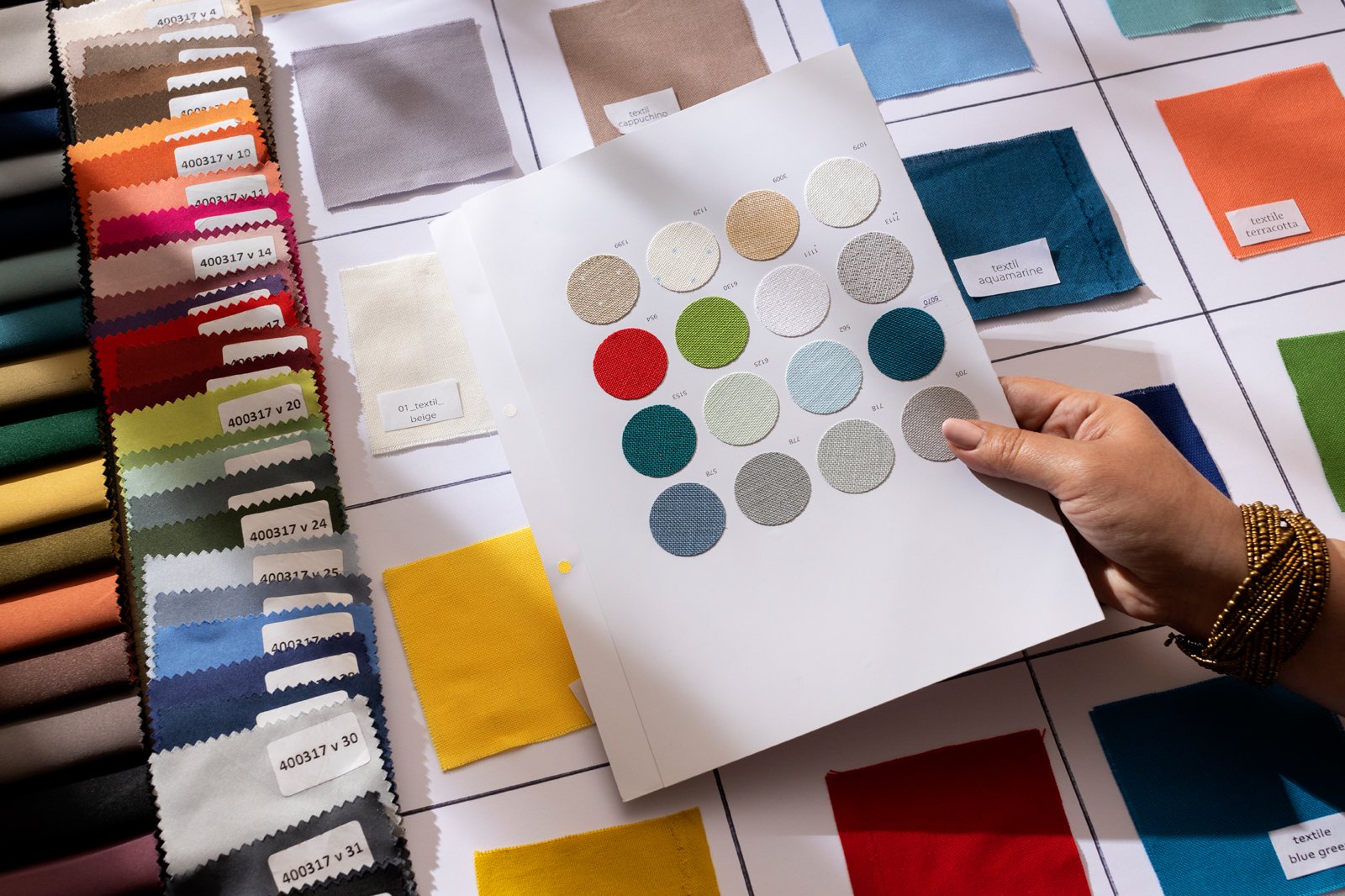
How Fashion Designers Choose the Right Fabrics
Every design begins as an idea on paper. But the idea only becomes real when a fabric is chosen. Fabric is not a detail added at the end. It is the foundation. It determines shape, feel and movement. For a fashion student, learning how to select fabric is one of the most important steps in turning design into practice.
This guide takes you through the main things designers look at when choosing fabrics.
Start with the Hand of the Cloth
Designers always begin with touch. In fashion, the “hand” is how a fabric feels. Is it smooth, rough, crisp, soft, heavy or light? Touching the fabric tells you if it suits the design. A stiff fabric may give structure to a jacket. A smooth fabric may drape gently for a dress.
Tip for students: Always handle fabrics in person. Don’t rely only on photos or descriptions. Twist them, fold them and see how they respond.
Weight and Drape
The weight of a fabric controls its drape and drape controls silhouette. A lightweight chiffon falls in soft waves. A heavy denim holds its shape. When you choose fabric, ask yourself: Does the drape support the design?
Tip for students: Hold the fabric up and let it fall. Imagine how it would move on the body.
Colour and How It Holds Dye
Fabric and colour are inseparable. The same dye appears differently on silk, cotton or linen. Silk shines, linen absorbs, cotton stays even. Designers test how colours look under natural light, artificial light and after washing.
Tip for students: Always look at swatches in daylight. Lighting in studios and shops can mislead you.
Durability and Purpose
Clothes are meant to be worn and fabrics must match the purpose. Wool keeps warmth but can shrink. Linen breathes well but wrinkles. Polyester blends may resist wear but sometimes lack elegance.
Tip for students: Think about where and how the garment will be worn. A gown can afford delicacy. Workwear cannot.
Movement Matters
Fabric is not static. It walks, bends and stretches with the wearer. Designers watch how fabric behaves in motion. Does it cling? Does it flow? Does it restrict? Movement can make or break a design.
Tip for students: Pin fabric on a dress form and move it around. See if it follows or resists the shape.
Cost and Supply
A perfect fabric is useless if it is too expensive or hard to source. High fashion sometimes allows rare textiles, but ready-to-wear must be realistic.
Tip for students: Always ask suppliers about minimum order quantities and timelines. Availability is as important as quality. Reliable suppliers in India, such as established fabric wholesale manufacturers, keep popular designs in constant stock and make planning easier for designers. Cirocco Fabrics, for example, offers “Never Out of Stock” collections that give buyers peace of mind when developing seasonal lines.
Tradition and Innovation
Every fabric carries history. Tweed brings to mind British tailoring. Denim carries workwear roots. Silk often suggests luxury. At the same time, new fabrics appear every year—blends with stretch, water resistance or eco-friendly properties.
Tip for students: Learn both the classics and the innovations. You will need both in your career.
Season and Climate
Fabrics must fit the season. Wool for winter. Linen for summer. But fashion is global. A spring jacket may be worn in hot Goa or cool London. Designers think about breathability, insulation and comfort across climates.
Tip for students: Imagine your design being sold worldwide. Would the fabric still work?
Sustainability
Today, designers cannot ignore sustainability. Fabrics now come with questions: Is the cotton organic? Is the polyester recycled? Was the dyeing process safe for workers and water systems?
Tip for students: Stay informed. Knowing the story behind a fabric is as important as knowing how it feels.
Learn from Makers
Fabric choice is rarely done alone. Designers talk to mills and suppliers, asking about fibre content, weave and finishing. These conversations teach you how fabrics behave.
Tip for students: Build relationships with suppliers. Ask questions. The best designers learn directly from fabric makers. Some suppliers, like Cirocco Fabrics, act as partners rather than vendors. With more than 90 years in textiles, we provide not only a wide library of designer clothing fabrics but also the knowledge and guidance that help a fashion designer match fabric to purpose.
The Final Test: Make a Sample
No matter how careful the selection, the truth appears only when the fabric is cut and sewn. A sample reveals whether seams hold, hems lie flat and drape matches the sketch.
Tip for students: Never skip the sample stage. Swatches mislead. A test garment tells the truth.
Bringing It All Together
Choosing fabric is not a single step. It is a process of touch, testing and reflection. Designers balance hand, drape, colour, movement, cost and sustainability. They consider history, climate and supply. Above all, they let fabric guide design.
For fashion students, the lesson is clear: learn fabrics as carefully as you learn drawing. Build the habit of touching, testing and questioning. In time, you will develop an instinct. And that instinct will turn ideas on paper into clothes that move, endure and speak with authority. In India, Cirocco Fabrics balance tradition with new ideas, offering designers fabrics that feel both timeless and modern. Choosing the right partner matters. Whether you are sourcing designer clothing fabric for a small collection or working with fabric wholesale manufacturers to plan a larger line, the fabric you select will shape how your work comes to life as a fashion designer.

